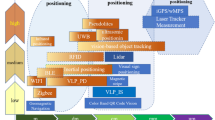Abstract
As one of the most popular categories of mobile services, a rapid growth of indoor location-based services has been witnessed over the past decades. Indoor positioning methods based on Wi-Fi, radio-frequency identification or Bluetooth are widely commercialized; however, they have disadvantages such as low accuracy or high cost. An emerging method using visible light is under research recently. The existed visible light positioning (VLP) schemes using carrier allocation, time allocation and multiple receivers all have limitations. This paper presents a novel mechanism using particle filtering in VLP system. By this method no additional devices are needed and the occlusion problem in visible light would be alleviated which will effectively enhance the flexibility for indoor positioning.






Similar content being viewed by others
References
Sheng, Z.H.O.U.: IEEE Trans on Consumer Electronics 52, 555 (2006)
Tan, K., Law, C.: Int. Conf. on ICSP, p 1 (2007)
Saad, M.M.: IEEE Trans Instrum Meas 61, 1561 (2012)
Yanying, G.: IEEE Commun. Surveys Tutor 11, 13 (2009)
O’brien D, Zeng, L.: Proc. PIMRC, p 1 (2008)
Armstrong, J., Sekercioglu, Y.: Comm Magazine 51, 68 (2013)
Thomas, Q., Wang, Sekercioglu, Y.A.: J. Lightwave Technol. 20, 3302 (2013)
Yang, Se-Hoon, Jung, Eun-Mi: Comm Lett 17, 1834 (2013)
Sertthin, C., Fujii, Takeo: GLOBECOM, p 1, (2011)
Hyun-Seung, K., Deok-Rae, K.: J. Lightwave Technol. 31(1), 134 (2013)
Arnaud, D., Adam, M. J.: Oxford handbook of nonlinear filtering p 656 (2011)
Doucet, A., Godsill, S.: Statistics and computing, p 197 (2000)
Gustafsson, F.: MEAS 25, 53 (2010)
Arulampalam, M.S.: IEEE Trans on Signal Processing 50, 174 (2002)
Andrieu, C., Doucet, A., Holenstein, R.: J. Royal Statistical Society 72, 269 (2010)
Oliver, N.M., Rosario, B., Pentland, A.P.: IEEE Trans PAMI 22, 831 (2000)
Rahaim, M.: GLOBECOM, p 1249, (2012)
Chinnapat S.: GLOBECOM, p 1, (2011)
Yang, S.-H.: Elec Lett 49, 54 (2013)
Zhou, Z., Mohsen K.: Proc. optical engineering, p 1 (2012)
Sidenbladh H., Black, M.: IEEE ICCV, p 709 (2001)
Acknowledgments
This research was supported in part by National 973 Program (No. 2013CB329205), National Science Foundation of China (No. 61401032), and National 863 Program (No. 2013AA013601).
Author information
Authors and Affiliations
Corresponding author
Rights and permissions
About this article
Cite this article
Jiang, M., Huang, Z., Li, J. et al. Indoor anti-occlusion visible light positioning systems based on particle filtering. Opt Rev 22, 294–298 (2015). https://doi.org/10.1007/s10043-015-0068-7
Received:
Accepted:
Published:
Issue Date:
DOI: https://doi.org/10.1007/s10043-015-0068-7




